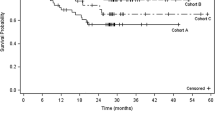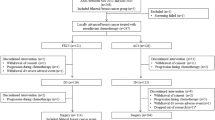Abstract
Sequential doxorubicin/paclitaxel (AT) followed by CMF treatment was shown to be an active neoadjuvant chemotherapy regimen in the first European Cooperative Trial in Operable Breast Cancer (ECTO I trial). The aim of the current study (ECTO II) is to assess the complete pathological response (pCR) rate following three different anthracycline and taxane-containing neoadjuvant chemotherapy regimens, with or without capecitabine (X). Patients with operable, invasive breast cancer >2.0 cm in diameter, were randomized to AT→CMF, AT→CMX or AC→TX regimens in two parallel, randomized, open-label, phase II trials (within a single study) in patients with estrogen receptor negative (ER−) and estrogen receptor positive (ER+) diseases, respectively. Exemestane was delivered concomitantly with neoadjuvant chemotherapy in ER+ tumors. Achievement of pCR was more common in ER− than ER+ women (45.3 vs. 10.4%). Capecitabine was only associated with a higher frequency of pCR in ER+ patients receiving AT→CMX. Overall response rates (ORR) ranged from 88 to 97%, and this translated into high rates of breast-conserving surgery (67% of ER− patients and 72% of ER+ patients). All three regimens were well tolerated. Febrile neutropenia and gastrointestinal effects were the most common grade ≥3 adverse events. As expected, the ECTO II study showed higher pCR rates in patients with ER− disease. Substituting capecitabine for fluorouracil (± methotrexate) in anthracycline/taxane-containing regimens appeared to be beneficial only in ER+ tumors. Translational studies investigating interactions between therapeutic agents and tumor biology are warranted to refine patient selection and improve the results of neoadjuvant chemotherapy.

Similar content being viewed by others
References
Untch M, von Minckwitz G (2009) Recent advances in systemic therapy: advances in neoadjuvant (primary) systemic therapy with cytotoxic agents. Breast Cancer Res 11:203
Bonadonna G, Valagussa P, Brambilla C et al (1998) Primary chemotherapy in operable breast cancer: eight-year experience at the Milan Cancer Institute. J Clin Oncol 16:93–100
Guarneri V, Broglio K, Kau SW et al (2006) Prognostic value of pathologic complete response after primary chemotherapy in relation to hormone receptor status and other factors. J Clin Oncol 24:1037–1044
Mauri D, Pavlidis N, Ioannidis JP (2005) Neoadjuvant versus adjuvant systemic treatment in breast cancer: a meta-analysis. J Natl Cancer Inst 97:188–194
Bear HD, Anderson S, Brown A et al (2003) The effect on tumor response of adding sequential preoperative docetaxel to preoperative doxorubicin and cyclophosphamide: preliminary results from national surgical adjuvant breast and bowel project protocol B-27. J Clin Oncol 21:4165–4174
von Minckwitz G, Raab G, Caputo A et al (2005) Doxorubicin with cyclophosphamide followed by docetaxel every 21 days compared with doxorubicin and docetaxel every 14 days as preoperative treatment in operable breast cancer: the GEPARDUO study of the German breast group. J Clin Oncol 23:2676–2685
Gianni L, Baselga J, Eiermann W et al (2005) Feasibility and tolerability of sequential doxorubicin/paclitaxel followed by cyclophosphamide, methotrexate, and fluorouracil and its effects on tumor response as preoperative therapy. Clin Cancer Res 11:8715–8721
Goldhirsch A, Ingle JN, Gelber RD et al (2009) Thresholds for therapies: highlights of the St Gallen international expert consensus on the primary therapy of early breast cancer 2009. Ann Oncol 20:1319–1329
Kaufmann M, von Minckwitz G, Bear HD et al (2007) Recommendations from an international expert panel on the use of neoadjuvant (primary) systemic treatment of operable breast cancer: new perspectives 2006. Ann Oncol 18:1927–1934
Bear HD, Anderson S, Smith RE et al (2006) Sequential preoperative or postoperative docetaxel added to preoperative doxorubicin plus cyclophosphamide for operable breast cancer: national surgical adjuvant breast and bowel project protocol B-27. J Clin Oncol 24:2019–2027
Gianni L, Baselga J, Eiermann W et al (2009) Phase III trial evaluating the addition of paclitaxel to doxorubicin followed by cyclophosphamide, methotrexate, and fluorouracil, as adjuvant or primary systemic therapy: European cooperative trial in operable breast cancer. J Clin Oncol 27:2474–2481
O’Shaughnessy JA (2003) The evolving role of capecitabine in breast cancer. Clin Breast Cancer 4(Suppl 1):S20–S25
Gradishar WJ, Meza LA, Amin B et al (2004) Capecitabine plus paclitaxel as front-line combination therapy for metastatic breast cancer: a multicenter phase II study. J Clin Oncol 22:2321–2327
Batista N, Perez-Manga G, Constenla M et al (2004) Phase II study of capecitabine in combination with paclitaxel in patients with anthracycline-pretreated advanced/metastatic breast cancer. Br J Cancer 90:1740–1746
Mariani G, Petrelli F, Zambetti M et al (2006) Capecitabine/cyclophosphamide/methotrexate for patients with metastatic breast cancer: a dose-finding, feasibility, and efficacy study. Clin Breast Cancer 7:321–325
Fisher B, Bryant J, Wolmark N et al (1998) Effect of preoperative chemotherapy on the outcome of women with operable breast cancer. J Clin Oncol 16:2672–2685
Simon R, Wittes RE, Ellenberg SS (1985) Randomized phase II clinical trials. Cancer Treat Rep 69:1375–1381
Wieand HS (2005) Randomized phase II trials: what does randomization gain? J Clin Oncol 23:1794–1795
von Minckwitz G, Rezai M, Loibl S et al (2010) Capecitabine in addition to anthracycline- and taxane-based neoadjuvant treatment in patients with primary breast cancer: phase III GeparQuattro study. J Clin Oncol 28:2015–2023
von Minckwitz G, Kummel S, Vogel P et al (2008) Neoadjuvant vinorelbine-capecitabine versus docetaxel-doxorubicin-cyclophosphamide in early nonresponsive breast cancer: phase III randomized GeparTrio trial. J Natl Cancer Inst 100:542–551
Ellis MJ, Ma C (2007) Letrozole in the neoadjuvant setting: the P024 trial. Breast Cancer Res Treat 105(Suppl 1):33–43
Eiermann W, Paepke S, Appfelstaedt J et al (2001) Preoperative treatment of postmenopausal breast cancer patients with letrozole: a randomized double-blind multicenter study. Ann Oncol 12:1527–1532
Smith IE, Dowsett M, Ebbs SR et al (2005) Neoadjuvant treatment of postmenopausal breast cancer with anastrozole, tamoxifen, or both in combination: the immediate preoperative anastrozole, tamoxifen, or combined with tamoxifen (IMPACT) multicenter double-blind randomized trial. J Clin Oncol 23:5108–5116
Dixon JM, Jackson J, Renshaw L et al (2003) Neoadjuvant tamoxifen and aromatase inhibitors: comparisons and clinical outcomes. J Steroid Biochem Mol Biol 86:295–299
Semiglazov VF, Semiglazov VV, Dashyan GA et al (2007) Phase 2 randomized trial of primary endocrine therapy versus chemotherapy in postmenopausal patients with estrogen receptor-positive breast cancer. Cancer 110:244–254
Pico C, Martin M, Jara C et al (2004) Epirubicin-cyclophosphamide adjuvant chemotherapy plus tamoxifen administered concurrently versus sequentially: randomized phase III trial in postmenopausal node-positive breast cancer patients. A GEICAM 9401 study. Ann Oncol 15:79–87
Untch M, Rezai M, Loibl S et al (2010) Neoadjuvant treatment with trastuzumab in HER2-positive breast cancer: results from the GeparQuattro study. J Clin Oncol 28:2024–2031
Precht LM, Lowe KA, Atwood M et al (2010) Neoadjuvant chemotherapy of breast cancer: tumor markers as predictors of pathologic response, recurrence, and survival. Breast J 16:362–368
Bhargava R, Beriwal S, Dabbs DJ et al (2010) Immunohistochemical surrogate markers of breast cancer molecular classes predicts response to neoadjuvant chemotherapy: a single institutional experience with 359 cases. Cancer 116:1431–1439
Carey LA, Dees EC, Sawyer L et al (2007) The triple negative paradox: primary tumor chemosensitivity of breast cancer subtypes. Clin Cancer Res 13:2329–2334
Gianni L, Eiermann W, Semiglazov V et al (2010) Neoadjuvant chemotherapy with trastuzumab followed by adjuvant trastuzumab versus neoadjuvant chemotherapy alone, in patients with HER2-positive locally advanced breast cancer (the NOAH trial): a randomised controlled superiority trial with a parallel HER2-negative cohort. Lancet 375:377–384
Buzdar AU, Ibrahim NK, Francis D et al (2005) Significantly higher pathologic complete remission rate after neoadjuvant therapy with trastuzumab, paclitaxel, and epirubicin chemotherapy: results of a randomized trial in human epidermal growth factor receptor 2-positive operable breast cancer. J Clin Oncol 23:3676–3685
Pierga JY, Delaloge S, Espie M et al (2010) A multicenter randomized phase II study of sequential epirubicin/cyclophosphamide followed by docetaxel with or without celecoxib or trastuzumab according to HER2 status, as primary chemotherapy for localized invasive breast cancer patients. Breast Cancer Res Treat 122:429–437
Buzdar AU, Valero V, Ibrahim NK et al (2007) Neoadjuvant therapy with paclitaxel followed by 5-fluorouracil, epirubicin, and cyclophosphamide chemotherapy and concurrent trastuzumab in human epidermal growth factor receptor 2-positive operable breast cancer: an update of the initial randomized study population and data of additional patients treated with the same regimen. Clin Cancer Res 13:228–233
Joensuu H, Kellokumpu-Lehtinen PL, Huovinen R et al (2009) Adjuvant capecitabine in combination with docetaxel and cyclophosphamide plus epirubicine for breast cancer: an open-label, randomised controlled trial. Lancet Oncol 10:1145–1151
ATAC Trialists’ Group (2005) Results of the ATAC (arimidex, tamoxifen, alone or in combination) trial after completion of 5 years’ adjuvant treatment for breast cancer. Lancet 365:60–62
BIG 1-98 Collaborative Group (2005) A comparison of letrozole and tamoxifen in postmenopausal women with early breast cancer. N Engl J Med 353:2747–2757
Smith IE, Dowsett M, Yap YS et al (2006) Adjuvant aromatase inhibitors for early breast cancer after chemotherapy-induced amenorrhoea: caution and suggested guidelines. J Clin Oncol 24:2444–2447
Gnant M, Mlineritsch B, Stoeger H, et al. on behalf of the Austrian Breast and colorectal cancer study group, Vienna, Austria (2011) Adjuvant endocrine therapy plus zoledronic acid in premenopausal women with early-stage breast cancer: 62-month follow-up from the ABCSG-12 randomised trial. Lancet Oncol (in press)
Acknowledgments
The authors are indebted to all the patients who have participated in our clinical trial and to the many associates, in particular medical oncologists, surgeons, radiation therapists, pathologists, research nurses, and data managers for their cooperation during the study. The authors are particularly indebted to the members of the International Advisory Board: Dr. John Bryant, Dr. Gabriel Hortobagyi, Dr. Larry Norton, Dr. Abraham Recht, and Dr. William Wood. The authors would like to thank Dr Claire Barton for assistance in preparing the manuscript, Rossella Vio and Lidia Mariani from the Michelangelo Operations Office, and Sergi Hernandez from SOLTI for coordinating the Spanish sites. The study was supported by unrestricted grants from Bristol-Myers Squibb, Roche and Pfizer.
Author information
Authors and Affiliations
Corresponding author
Appendix: List of active ECTO II participating centers
Appendix: List of active ECTO II participating centers
Coordinating Center, Istituto Nazionale Tumori, Milano, Italy:, L. Gianni, M. Zambetti, E. De Benedictis
Ospedale Universitario S. Maria della Misericordia, Udine, Italy: M. Mansutti, G. Gentile
Hospital Vall d’Hebron, Barcelona, Spain: P. Gomez
Hospital Clinico Universitario de Valencia, Valencia, Spain: A. Lluch
Ludwig Boltzmann – Institute for Applied Cancer Research, Kaiser Franz Josef-Spital, Wien, Austria: C. Dittrich
Ospedale Policlinico S. Orsola Malpighi, Bologna, Italy: C. Zamagni
Hospital Universitario 12 de Octubre, Madrid, Spain: E. Ciruelos
Fondazione Salvatore Maugeri, Pavia, Italy: L. Pavesi
N.N. Petrov Research Institute of Oncology, St. Petersburg, Russian Federation: V. Semiglazov
Ospedale Civile di Camposampiero, Camposampiero, Italy: F. Gaion
Presidio Ospedaliero di Noale, Noale, Italy: M. Bari
Ospedale S. Bortolo, Vicenza, Italy: P. Morandi
Hospital de San Pau, Barcelona, Spain: B. Ojeda
Ospedale S. Giovanni Battista, Torino, Italy: M. Donadio
Hospital Arnau de Vilanova, Lleida, Spain: A. Llombart
Ospedale Civile di Legnano, Legnano, Italy: S. Fava
Frauenklinik vom Roten Kreuz, Munich, Germany: W. Eiermann
Istituto San Raffaele, Milano, Italy: E. Villa
Presidio Ospedaliero di Saronno, Saronno, Italy: C. Verusio
University Hospital Dr. Peset, Valencia, Spain: S. Olmos
Hospital Clíníco Universitario Lozano Bleza de Zaragoza, Zaragoza, Spain: R. Andrés
Medizinisches Zentrum, Ulm, Germany: C.Wolf
Istituto Valenciano de Oncologia, Valencia, Spain: M. A. Climent
Rights and permissions
About this article
Cite this article
Zambetti, M., Mansutti, M., Gomez, P. et al. Pathological complete response rates following different neoadjuvant chemotherapy regimens for operable breast cancer according to ER status, in two parallel, randomized phase II trials with an adaptive study design (ECTO II). Breast Cancer Res Treat 132, 843–851 (2012). https://doi.org/10.1007/s10549-011-1660-6
Received:
Accepted:
Published:
Issue Date:
DOI: https://doi.org/10.1007/s10549-011-1660-6




